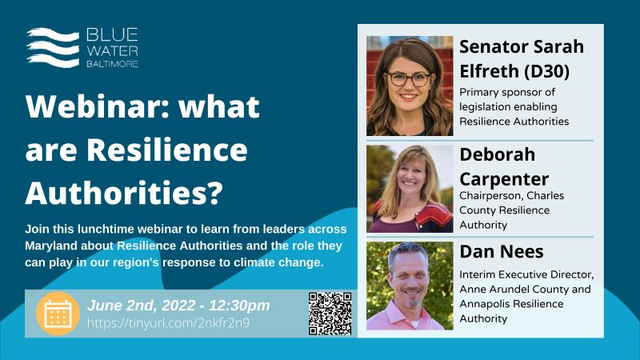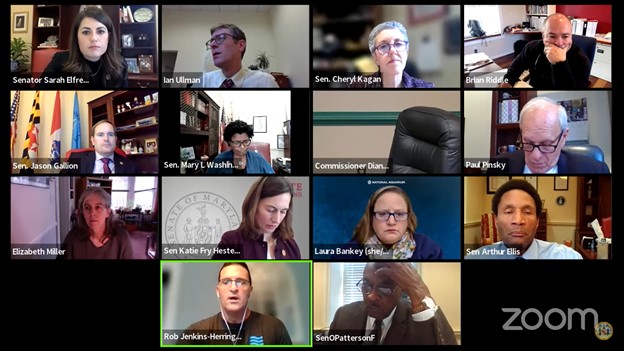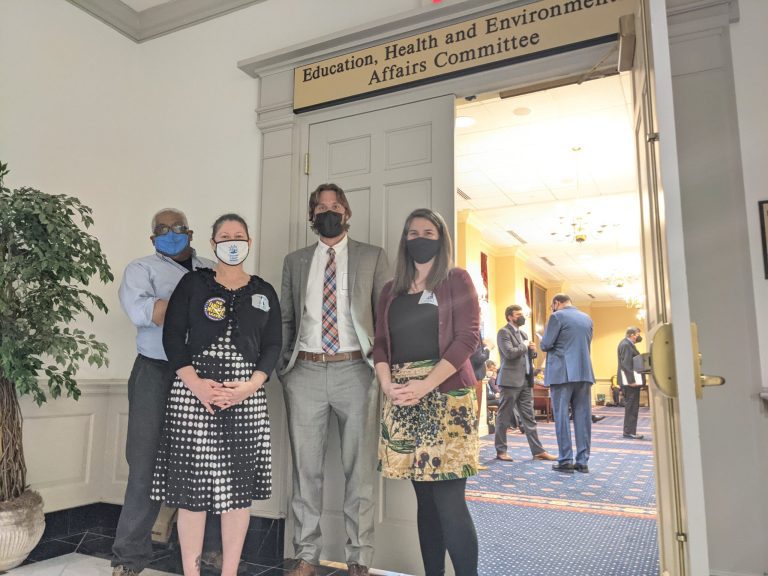Webinar Highlights Exciting New Strategy to Build Climate Resilience
By Alex Norbrook
On Thursday, June 2, Blue Water Baltimore hosted a webinar to hear from leaders across Maryland who are spearheading the creation of local Resilience Authorities in response to the climate crisis.
Recognizing that local governments bear the burden of building, maintaining, and upgrading infrastructure to withstand the effects of climate change, the Maryland General Assembly passed SB457 in 2020 to enable local jurisdictions to form Resilience Authorities. These nonprofit, independent bodies can help cities and counties identify, secure, and allocate critical financing for resiliency infrastructure projects. Charles County and Anne Arundel County have been the first to create Resilience Authorities under the state law, and we want Baltimore to be next!
We invited Senator Sarah Elfreth (D30), lead sponsor of SB457, Deborah Carpenter, Chair of the Charles County Resilience Authority and Dan Nees, Interim Executive Director of the Resilience Authority of Annapolis and Anne Arundel County, to join us for a discussion about Resilience Authorities and the role they can play in our region’s response to climate change. The panelists were optimistic about the future of Resilience Authorities in Baltimore and beyond.
You can watch the recording of the webinar here. Below are some of our key takeaways from the conversation:
Resilience Authorities can be tailored to meet local needs.
Because Resilience Authorities are established by local jurisdictions, those jurisdictions have control over how their respective Authorities function and can ensure they prioritize the climate impacts most relevant to their communities. For instance, the Resilience Authority of Charles County set its top priorities to be stormwater, water, and agriculture because those are the most pressing climate issues to that county. In addition, each local jurisdiction that establishes an Authority determines the composition of their Authority’s board and can prioritize certain perspectives and areas of expertise. For example, a county which experiences extreme floods can make sure that flood experts are brought on board to contribute to planning.
Environmental justice can and must be a top priority for Resilience Authorities.
Financing infrastructure projects in Black, brown, and low-income communities is necessary to repair the state’s legacy of neglect and discrimination towards these communities. As a result of generations of disinvestment and discriminatory housing and land use policies, these communities are more likely to be in areas with greater risk of harm from climate hazards such as sea level rise, heat islands, and extreme storms. If designed from the outset to prioritize environmental justice principles through standards such as Justice40, Resilience Authorities can help advance environmental justice by prioritizing funding in the most impacted communities.
Resilience Authorities can leverage creative and innovative financing strategies.
As nonprofit instrumentalities, RAs are uniquely suited to tackle expensive, long-term infrastructure projects because they can operate outside of their jurisdiction’s budgets and debt ceiling restrictions. Authorities have their own procurement policies and can access revenue streams which are often out of reach to government bodies, such as grants, bonds, or loans from both the public and the private sector.
Resilience Authorities can create physical, positive change in communities.
The physical nature of the infrastructure projects an Authority finances can be seen and felt by the communities they serve. These physical interventions can transform the perception that climate change action is an abstract, international debate into a tangible problem with local solutions that can help people thrive amidst a changing climate.
Transparency within Resilience Authorities must be established from the beginning.
Though not government bodies, Authorities still have some built-in transparency measures: they must submit annual reports to the Maryland General Assembly, and if members are appointed by County or City elected officials, they must be subject to the Open Meetings Act and the Public Information Act. To go further, Authorities can follow the lead of Charles County’s Resilience Authority by making all meetings, minutes, and documents available to the public online.
The climate crisis is already impacting Baltimore’s communities, waterways, and environment, from raw sewage backing up into peoples’ homes during heavy rainstorms to the urban heat island effect exacerbating hot temperatures. Addressing these problems and increasing our region’s resilience in the face of climate impacts is going to require immense investment. Resilience Authorities present an exciting new way of funding infrastructure projects to reduce the harms the climate crisis causes.
Local officials in Baltimore have already expressed support for following Charles and Anne Arundel County’s lead and establishing a Resilience Authority. Sign up for our action alerts and stay tuned for opportunities to advocate for the creation of Resilience Authorities in Baltimore City and County to help advance environmental justice and increase climate resilience in our region.




